Guitar tablature, commonly known as “guitar tabs,” is a user-friendly system for writing down music that allows aspiring guitarists to quickly grasp and play their favorite songs. Think of guitar tabs as a simplified roadmap for music notation, especially designed for guitar. While sharing some similarities with traditional music notation by indicating notes, rhythm, and techniques, guitar tabs offer a significant advantage for guitarists: they visually represent where to play those notes directly on the guitar fretboard.
This is incredibly beneficial because the guitar allows you to play the same note in multiple locations across the neck. Understanding and learning to read guitar tablature is therefore an invaluable skill, particularly for beginners. It opens the door to playing guitar without the initial hurdle of learning standard musical notation.
At guitarplayers.net, we believe in empowering musicians with accessible learning tools. That’s why we’re dedicated to teaching you how to read guitar tabs. Tabs effectively display both chords and single notes, making them the quickest route to learning songs you love. The beauty of guitar tabs lies in their simplicity – no prior musical knowledge is required beyond understanding the strings and frets on your guitar.
Ready to demystify guitar tabs and discover their potential? Let’s dive in and get you started on your guitar playing journey.
What Exactly Are Guitar Tabs?
Guitar tablature is essentially a visual representation of the musical notes in a song, specifically tailored for guitar. A standard guitar tab is composed of six horizontal lines, each representing one of the six strings on a guitar. When learning how to read guitar tabs, you read them from top to bottom, mirroring the strings as you see them when holding your guitar. The topmost line corresponds to the high E string (the thinnest string), followed by lines for the B, G, D, A, and low E strings (the thickest string).
Think of guitar tablature as your personal guitar songbook in code. It provides a direct, visual pathway to learning guitar songs quickly and efficiently.
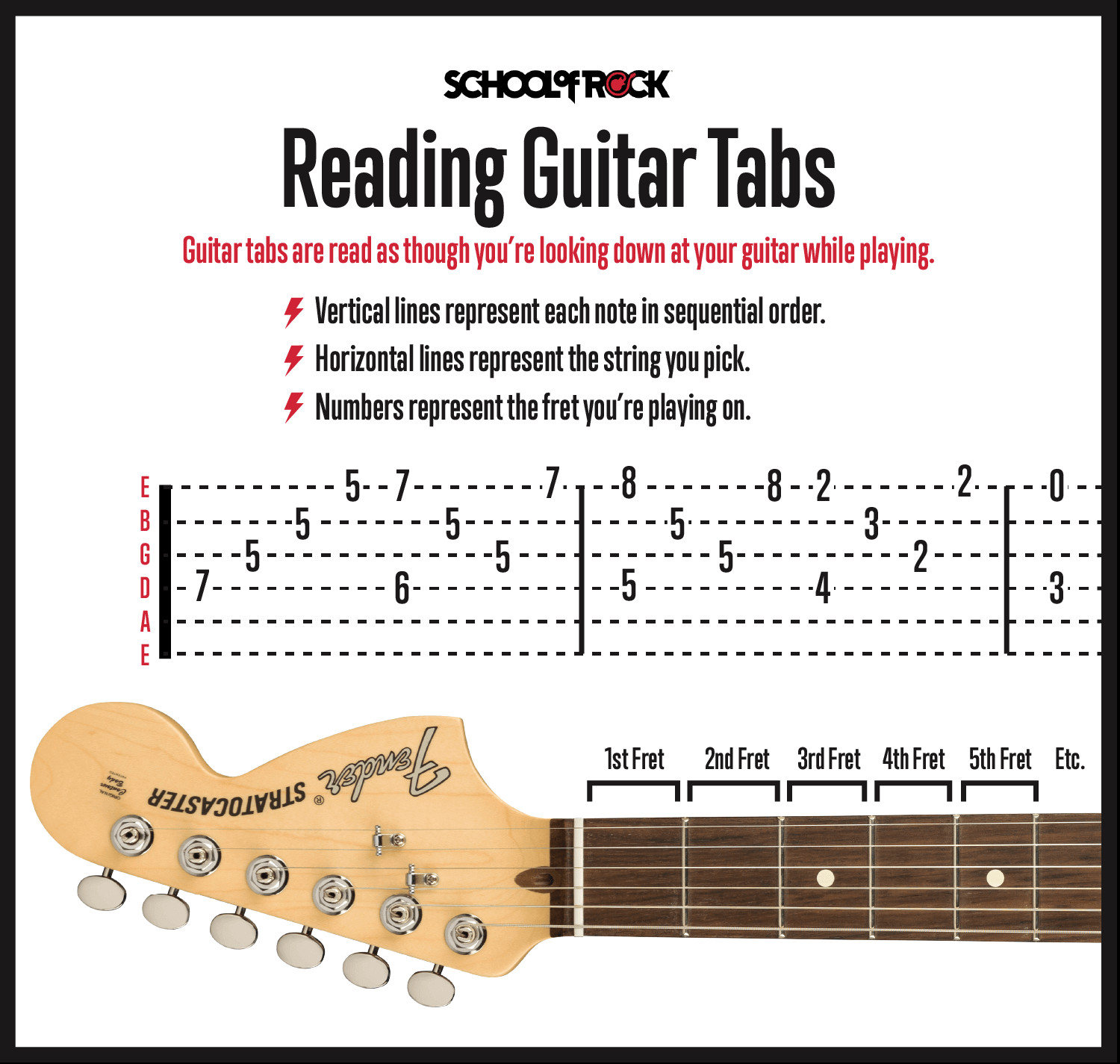 Guitar Tablature Explained: String Representation
Guitar Tablature Explained: String Representation
Within these lines, you’ll find numbers. These numbers indicate the fret you need to press down on the guitar neck. Frets are the metal strips running across the fretboard, numbered 0-24 starting from the nut (closest to the headstock).
A ‘0’ on a string means you play that string “open,” without pressing down any fret. A ‘1’ signifies playing the note at the first fret, ‘2’ at the second fret, and so on. Crucially, when learning how to decipher guitar tabs, remember that these numbers directly correspond to the fret number.
To further illustrate, here’s a visual demonstration of how tabs translate to the guitar:
 Visual Guide to Guitar Tabs
Visual Guide to Guitar Tabs
Decoding Guitar Tabs: Reading from Left to Right
Guitar tablature is read just like standard text, from left to right. The sequence of numbers and symbols you see represents the chronological order of notes in the music. When numbers are stacked vertically, one above the other on different lines, they represent a chord. A chord is played by strumming all the indicated strings simultaneously. For beginners, guitar tab notation excels over standard notation because it explicitly shows you both the notes comprising the chord and their exact location on the guitar.
Essential Knowledge for Reading Guitar Tabs
To successfully learn how to read guitar tabs, beginners should first become familiar with the names and order of the 6 guitar strings and the physical layout of the fretboard, including the fret positions. This foundational knowledge will enable you to quickly locate the correct notes on your guitar as guided by the tab.
Understanding the Tab Staff: Strings, Not Notes
The guitar tab staff visually resembles the staff used in traditional music notation, but with a key difference. In tabs, the lines represent the 6 guitar strings, not musical pitches directly. The top line is always the high E string, and the bottom line is the low E string. This direct string-to-line mapping is what makes reading and learning guitar tabs so intuitive, especially for beginners. Typically, a tab staff will also be labeled “TAB” to prevent confusion with standard notation.
Navigating Guitar Frets: The Numbered Landscape
Guitar frets, the metal strips across the fretboard, are the numbered landmarks in guitar tabs. Most guitars feature between 19 to 24 frets. Each fret represents a semitone or half step in musical pitch. Within each octave, there are 12 semitones (or frets). To aid navigation, guitars often have fret markers—inlays or dots—typically positioned at the 3rd, 5th, 7th, 9th, and 12th frets. These markers provide visual cues to easily identify fret positions while playing.
Remember the number ‘0’ for open strings and numbers ‘1’ and above for fretted notes. An open string is played without pressing down on any fret, simply by picking or plucking the string to produce sound.
Guitar Tab Chords: Vertical Harmony
Guitar chords in tabs are identified by their vertical arrangement. When multiple numbers are aligned vertically across different string lines, they indicate notes played together as a chord. Even if a chord is arpeggiated (played one note at a time), it will appear as individual notes in sequence, though you’ll still be holding down the chord shape with your fretting hand.
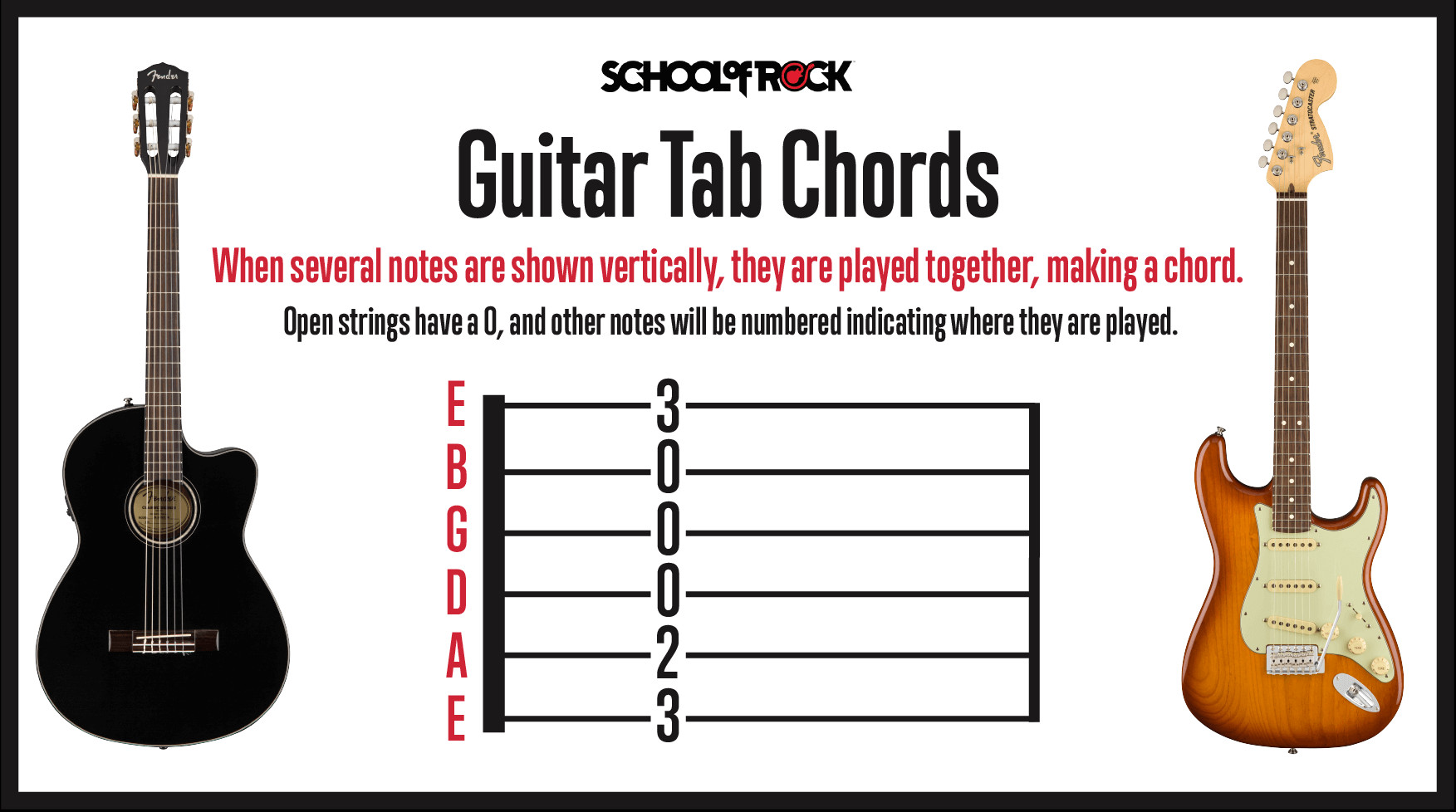 Reading Guitar Tab Chords: Vertical Alignment
Reading Guitar Tab Chords: Vertical Alignment
Guitar Tab Riffs: Melodic Phrases
Many rock and popular songs are built around “riffs”—short, repeated musical phrases. Riffs usually combine single notes and partial chords, often power chords. The same basic tab rules apply to riffs: vertically aligned notes are played simultaneously. This consistency makes learning how to read guitar tablature efficient and fast, even for complex musical passages.
Guitar Tabs vs. Chord Charts: Understanding the Difference
Guitar tabs and chord charts serve different but complementary purposes. A chord chart is a diagram visually showing you where to place your fingers on the fretboard to form a specific chord, and sometimes suggests which fingers to use. Chord charts are often included with guitar tabs, positioned above song lyrics to indicate chord changes within the song structure.
However, chord charts typically only display the 3 or 4 core notes that constitute a chord. A complete song arrangement might include additional single notes, notes outside the basic chord, or arpeggios (patterns of playing individual notes within a chord) that chord charts alone don’t capture. Therefore, chord charts often accompany guitar tabs to bridge the gap for beginner guitarists, helping them transition from basic chords to playing a full song arrangement.
Finger Numbering in Chord Charts: A Quick Guide
Chord charts often use a numbering system to indicate which fingers of your fretting hand should press down on which strings. The fingers are numbered 1 through 4: index finger (1), middle finger (2), ring finger (3), and pinky finger (4).
This is distinct from guitar tabs, where numbers represent frets, not fingers. Chord charts integrated with easy guitar tabs help beginners understand hand positioning while learning chords.
Experience Guitar Performance Live
Our guitar programs are led by experienced, practicing musicians. We offer a supportive and dynamic learning environment for all skill levels, focused on real-world performance skills.
Guitar Tab Symbols: Beyond Numbers and Lines
Beyond numbers and lines, guitar tabs use various symbols to indicate specific playing techniques. Understanding these symbols is crucial to making your playing sound authentic and accurately interpreting the composer’s intentions as written in the tab.
Before you start playing, always ensure your guitar is properly tuned. Tuning is fundamental to sound quality.
Muting Techniques in Guitar Tabs
Muting is a vital technique in many genres, especially rock music. Styles like heavy metal, punk, and alternative rock heavily rely on muting to create specific rhythmic textures and sonic characteristics.
Mastering Guitar Muting
Muting can be achieved with either your picking hand, your fretting hand, or a combination of both. It adds dynamic contrast to your playing and is a valuable skill for achieving a polished sound. Many songs utilize muting in verses for a subdued feel, contrasting with unmuted choruses or hooks for greater impact.
Experienced guitarists often use muting instinctively, especially in live performance settings. At stage volume, muting helps prevent unwanted string noise and feedback.
Palm Muting: The “P.M.” Symbol
Palm muting is a cornerstone technique in rock guitar. It involves resting the palm of your picking hand lightly on the strings near the bridge while picking. Heavy palm muting creates a tight, percussive, rhythmic sound, while lighter palm muting allows notes to sustain slightly more. In guitar tabs, palm muting is indicated by “P.M.” written above the section of tab where it should be applied.
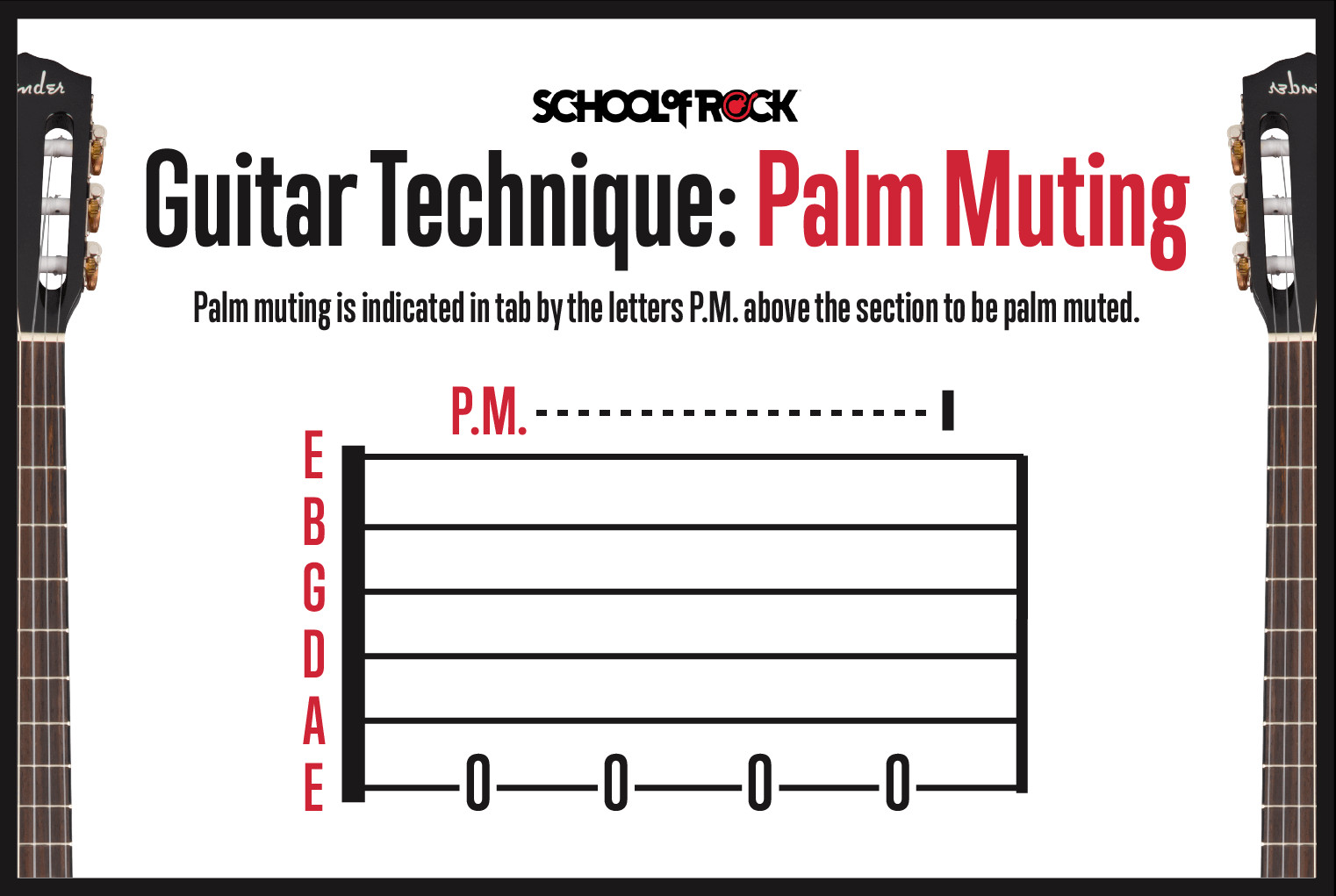 Palm Muting Technique in Guitar Tabs
Palm Muting Technique in Guitar Tabs
Muted Notes: The “X” Symbol
Muted notes are distinct from palm muting and are achieved using the fretting hand. In tabs, muted notes are still picked but don’t ring out clearly because the fretting hand lightly touches the strings without fully pressing them down to the fretboard. Muted notes are represented by an “X” in the tab where a fret number would normally appear.
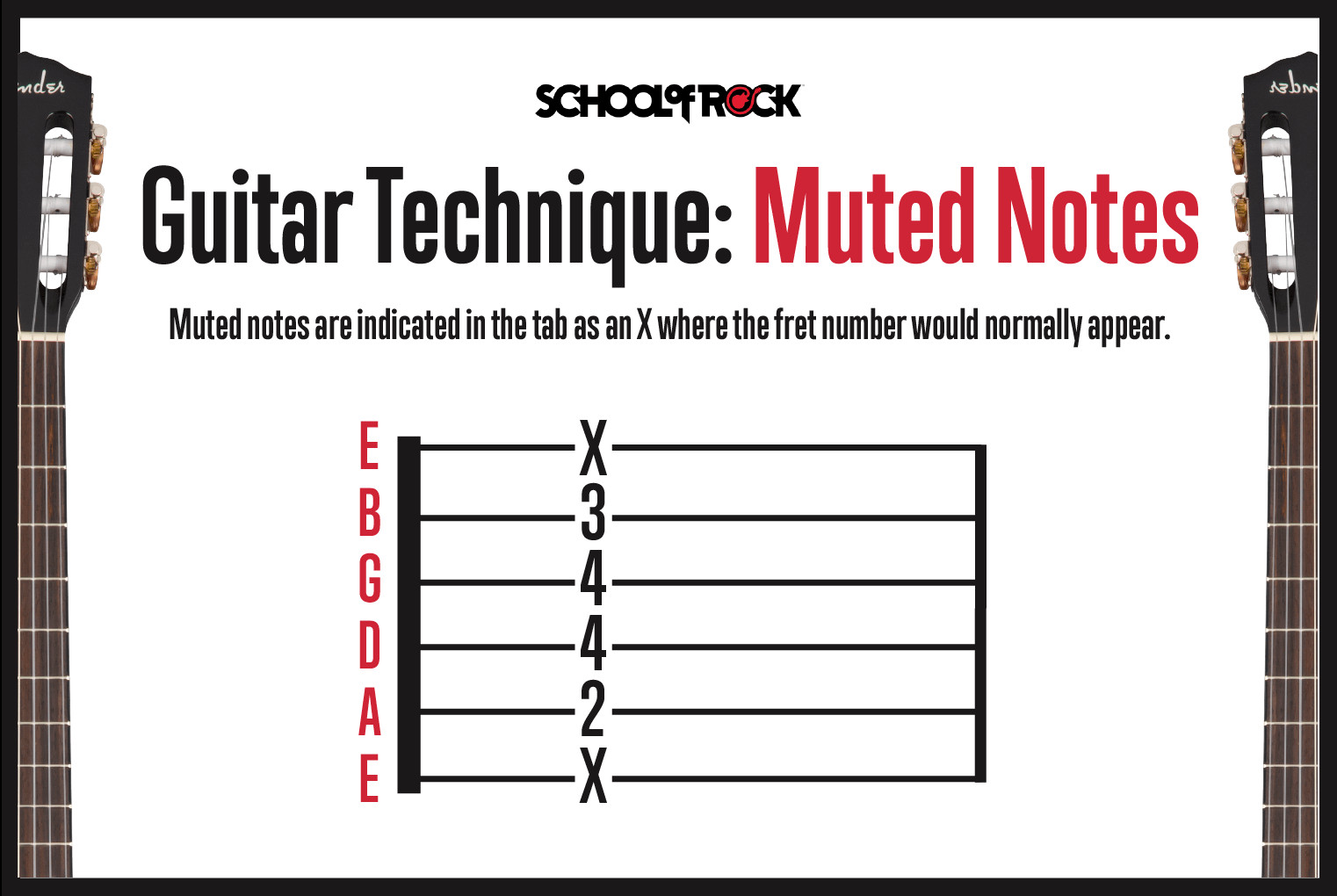 Muted Notes Technique in Guitar Tabs
Muted Notes Technique in Guitar Tabs
String Bending in Guitar Tabs
String bending adds expressive, vocal-like qualities to guitar playing. In guitar tabs, bends are usually indicated by a curved arrow above the note to be bent. The arrow might specify “½” or “full,” indicating a half-step (one fret) or full-step (two frets) bend, respectively. The target pitch of the bend is often referred to as the “target note.”
Executing Guitar Bends
Bending is done by pushing or pulling the string sideways along the fretboard, rather than pressing straight down. For most strings except the low E, you typically push upwards towards the ceiling. The low E string is usually bent downwards towards the floor. The key is to apply smooth, consistent pressure throughout the bend.
Bending Technique: Finger Support
Most bends are performed using 2 or 3 fingers for added strength and control. The primary fretting finger (often the ring finger) is supported by the middle and index fingers. This technique makes bending smoother, easier, and improves pitch control.
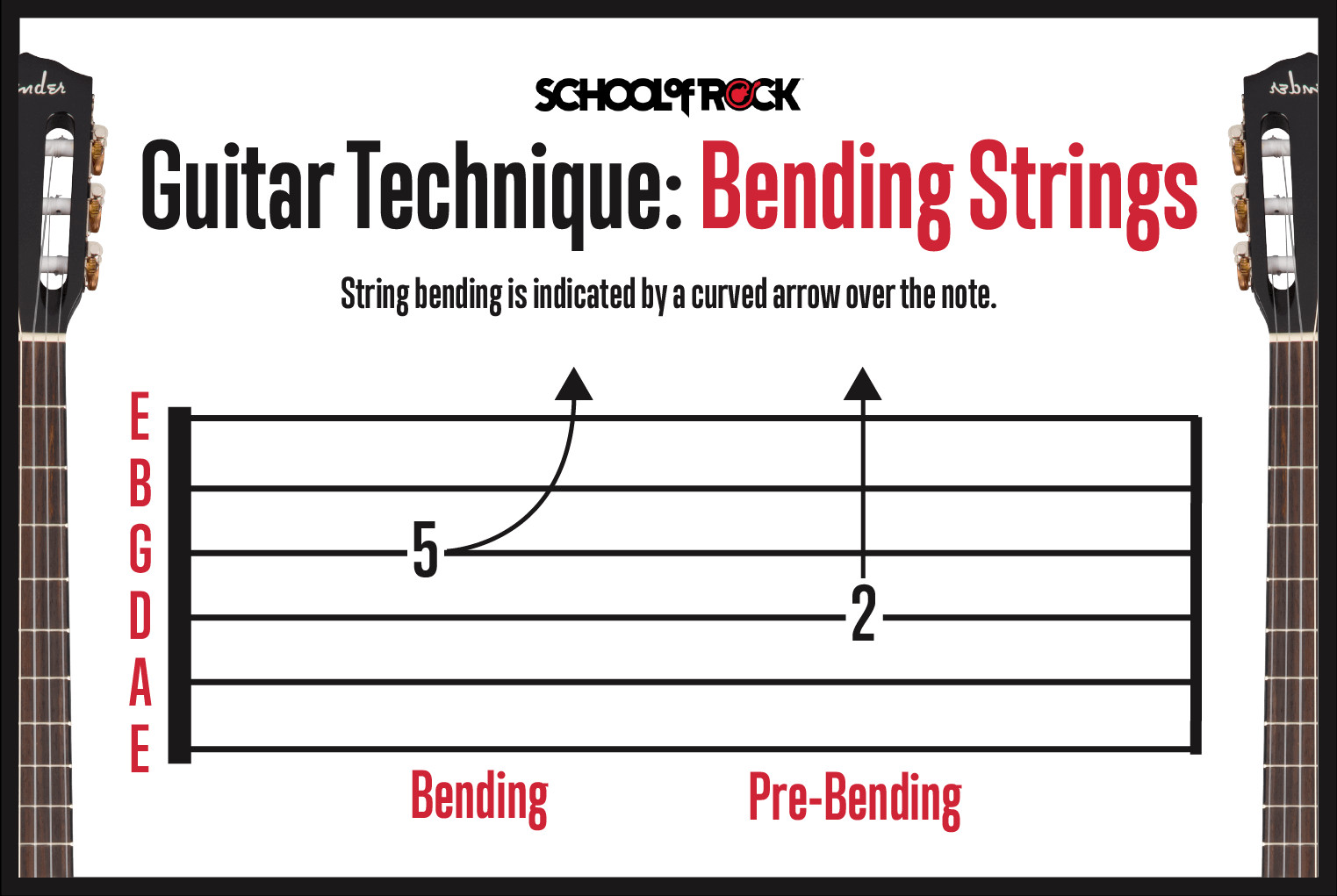 String Bending Technique in Guitar Tabs
String Bending Technique in Guitar Tabs
Pre-Bending: Anticipating the Bend
Beginners learning how to read guitar tabs might encounter “pre-bends.” In a pre-bend, the string is bent to the target pitch before being picked. The tab notation shows a straight upward arrow with the bend amount (full, ½, etc.), followed by a curved arrow downwards indicating the release back to the original fretted pitch after picking. Pre-bends can resolve back to the original note or bend further upwards to another target note.
Sliding Notes in Guitar Tabs
Sliding is another expressive technique, used to smoothly transition between notes. You can slide upwards (to a higher pitch) or downwards (to a lower pitch) to the next note. This differs from bending as you physically slide your fretting finger along the fretboard to the new fret.
Slide Up: Ascending Smoothly
A slide up in guitar tabs is represented by a line connecting the starting note to the ending note. If the slide is to a higher note, the line may angle slightly upwards.
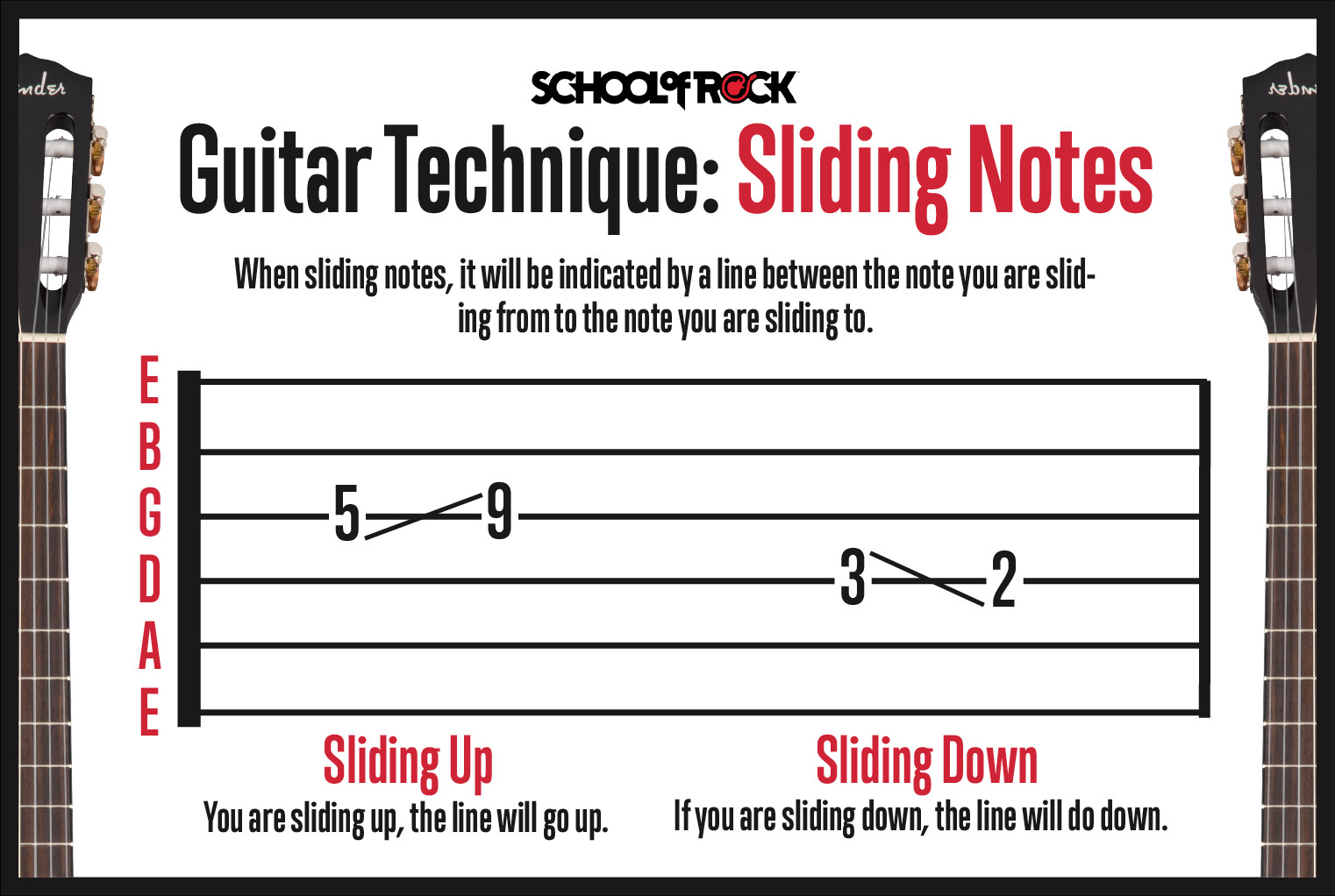 Slide Up Technique in Guitar Tabs
Slide Up Technique in Guitar Tabs
Slide Down: Descending Smoothly
Conversely, a slide down is shown by a line connecting the starting and ending notes, possibly angled slightly downwards if sliding to a lower note.
Hammer-Ons: Legato Articulation
The hammer-on is a technique where you articulate a note by “hammering” your fretting finger onto the string, without picking the note. You can hammer-on from an open string or from a lower fretted note to a higher one. Hammer-ons are indicated in guitar tabs by the letter “H” and an arc connecting the initial note to the hammered-on note.
Mastering Hammer-Ons
To execute a hammer-on, strike the string with your fretting finger with enough force to produce a clear note. This requires practice to achieve a strong, clean sound. Hammer-ons are generally easier to execute on electric guitars, especially at higher volumes. Start practicing by hammering-on from an open low E string to the third fret, and let the note ring. Repeat on different strings and frets.
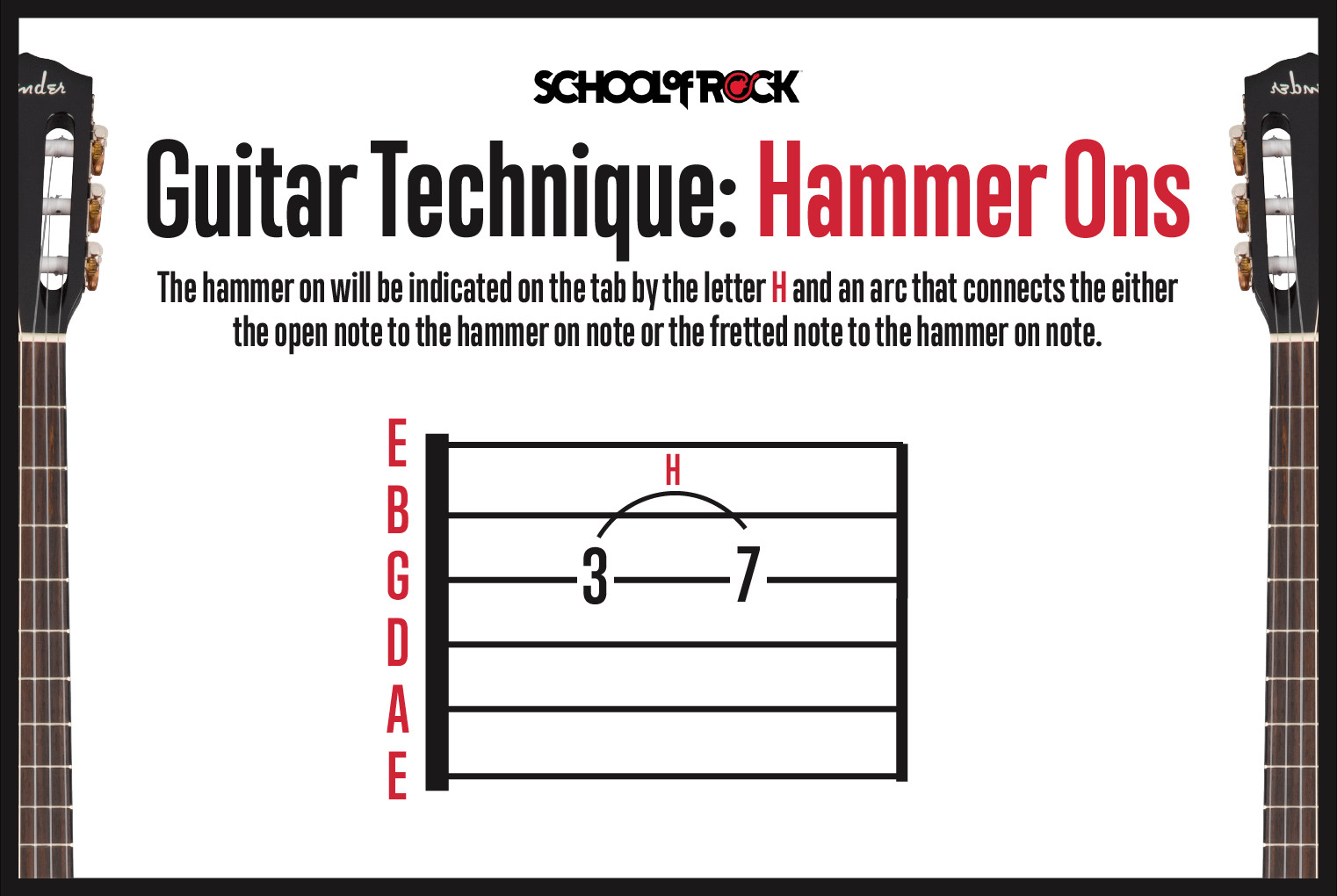 Hammer-On Technique in Guitar Tabs
Hammer-On Technique in Guitar Tabs
Pull-Offs: The Reverse Hammer-On
Pull-offs are the opposite of hammer-ons. You “pull off” a fretted string to sound either an open string or a lower fretted note. Pull-offs are shown in guitar tabs with the letter “P” and an arc connecting the pulled-off note to the resulting lower note.
Executing Pull-Offs
To perform a pull-off, fret a note, then pull your finger off the string in a sideways or downward motion, effectively plucking the string to sound the lower note. You need to “grab” enough of the string with your fingertip to make it vibrate clearly.
Hammer-ons and pull-offs can be combined in alternating sequences to create trills or legato passages.
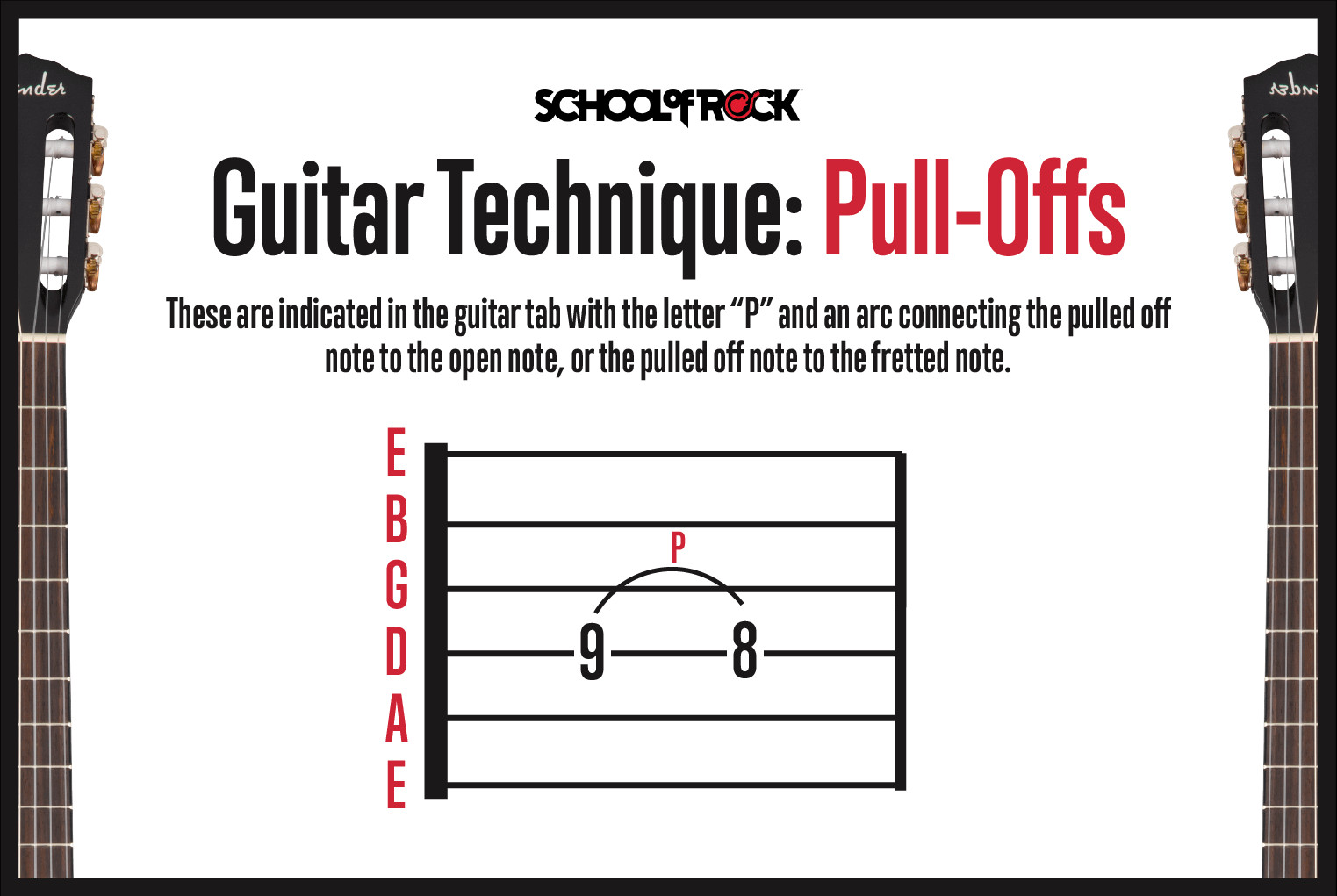 Pull-Off Technique in Guitar Tabs
Pull-Off Technique in Guitar Tabs
Vibrato: Adding Expression
Vibrato is a technique of subtly and repeatedly bending a note up and down in pitch without fully releasing it. This adds warmth, sustain, and expressiveness. Vibrato in guitar tabs is represented by a zig-zag line above the staff. The length of the zig-zag line often indicates the duration of the vibrato.
Achieving Vibrato
Vibrato is similar to bending, but with smaller pitch variations. You can apply vibrato with a single finger or use multiple fingers for support. Start with a slow, smooth vibrato and gradually vary the speed for different expressive effects. Like bending, vibrato is a highly personal technique, contributing to a guitarist’s unique sonic fingerprint.
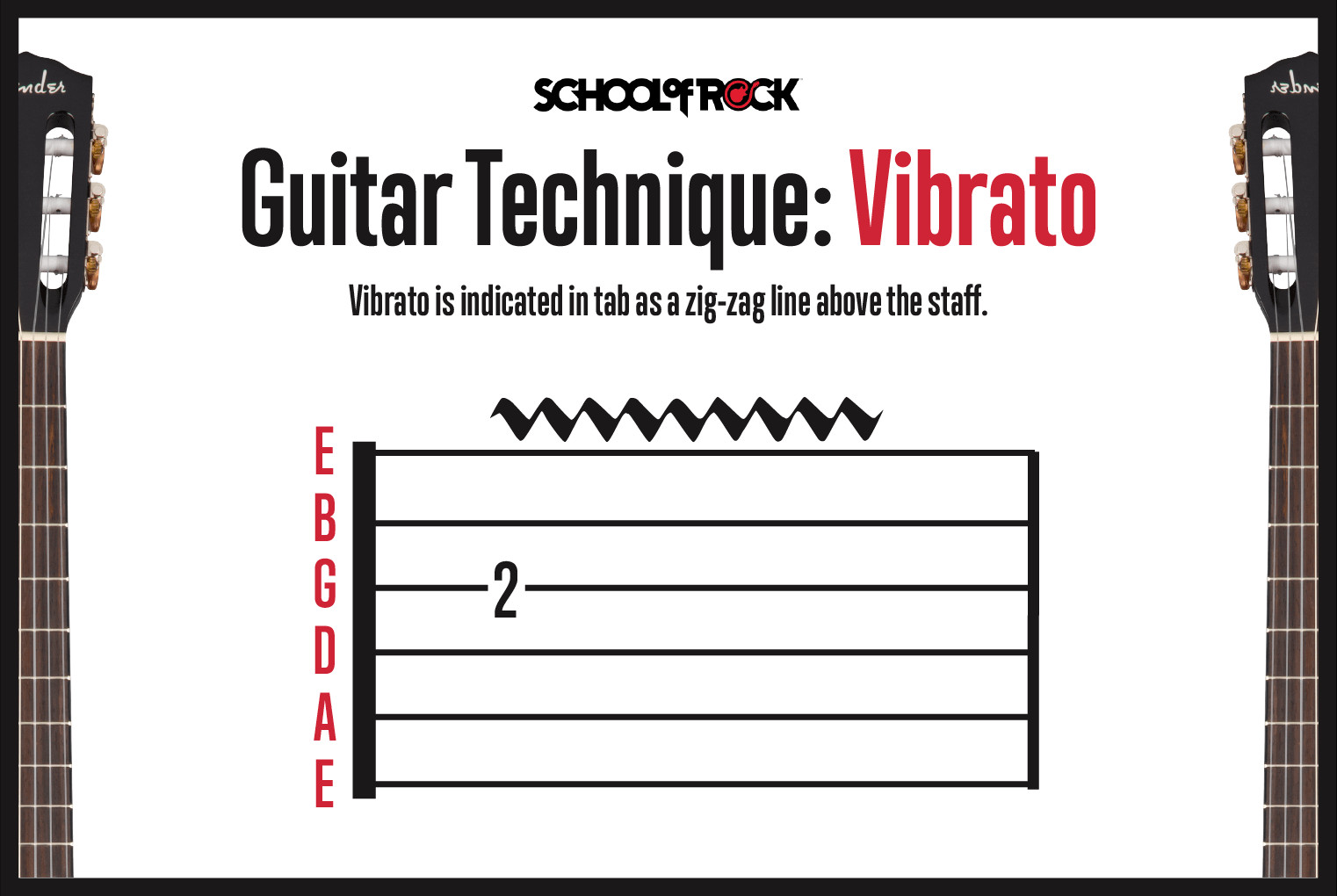 Vibrato Technique in Guitar Tabs
Vibrato Technique in Guitar Tabs
Tapping: Two-Handed Fretwork
Tapping involves using both hands on the fretboard. Your fretting hand plays notes in the usual way, while your picking hand “taps” or hammers-on notes, typically with the index finger. Picking-hand tapping is essentially a variation of a hammer-on. Tapping is indicated in guitar tabs by a “T” above the tapped note.
Mastering Finger Tapping
Eddie Van Halen popularized tapping, though the technique has roots in classical guitar. To tap, fret a note with your fretting hand, then tap a higher note on the same string with your picking hand’s index finger.
Tapping expands your playing range, allowing you to play intervals too wide to reach with just your fretting hand. Playing with overdrive or distortion and sufficient volume enhances the clarity and sustain of tapped notes. Tapping also facilitates fast playing due to both hands fretting notes.
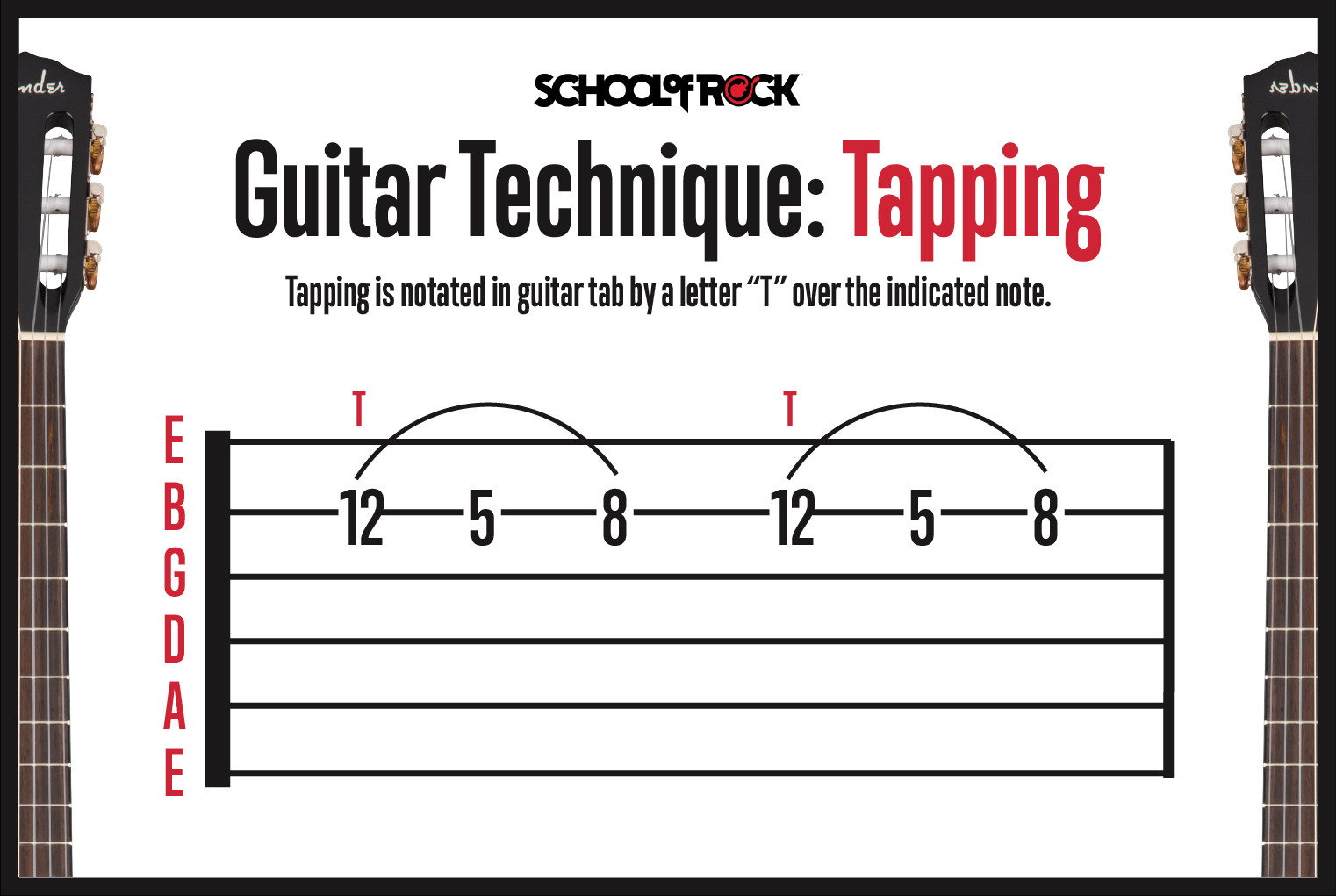 Tapping Technique in Guitar Tabs
Tapping Technique in Guitar Tabs
Two-Handed Tapping: Independent Lines
Two-handed tapping takes the technique further, with both hands independently hammering-on notes without traditional picking. This can involve the fretting hand tapping bass lines while the picking hand taps melody or solo lines, creating complex textures.
Strumming Notation in Guitar Tabs
When strumming chords, tabs use symbols to indicate downstrokes and upstrokes.
Downstrokes, starting on lower strings and ending on higher strings with a downward motion, are shown by a symbol resembling a thick horizontal line with downward “legs” on each side.
Upstrokes, the reverse motion from high to low strings, are notated by a “V” shaped symbol.
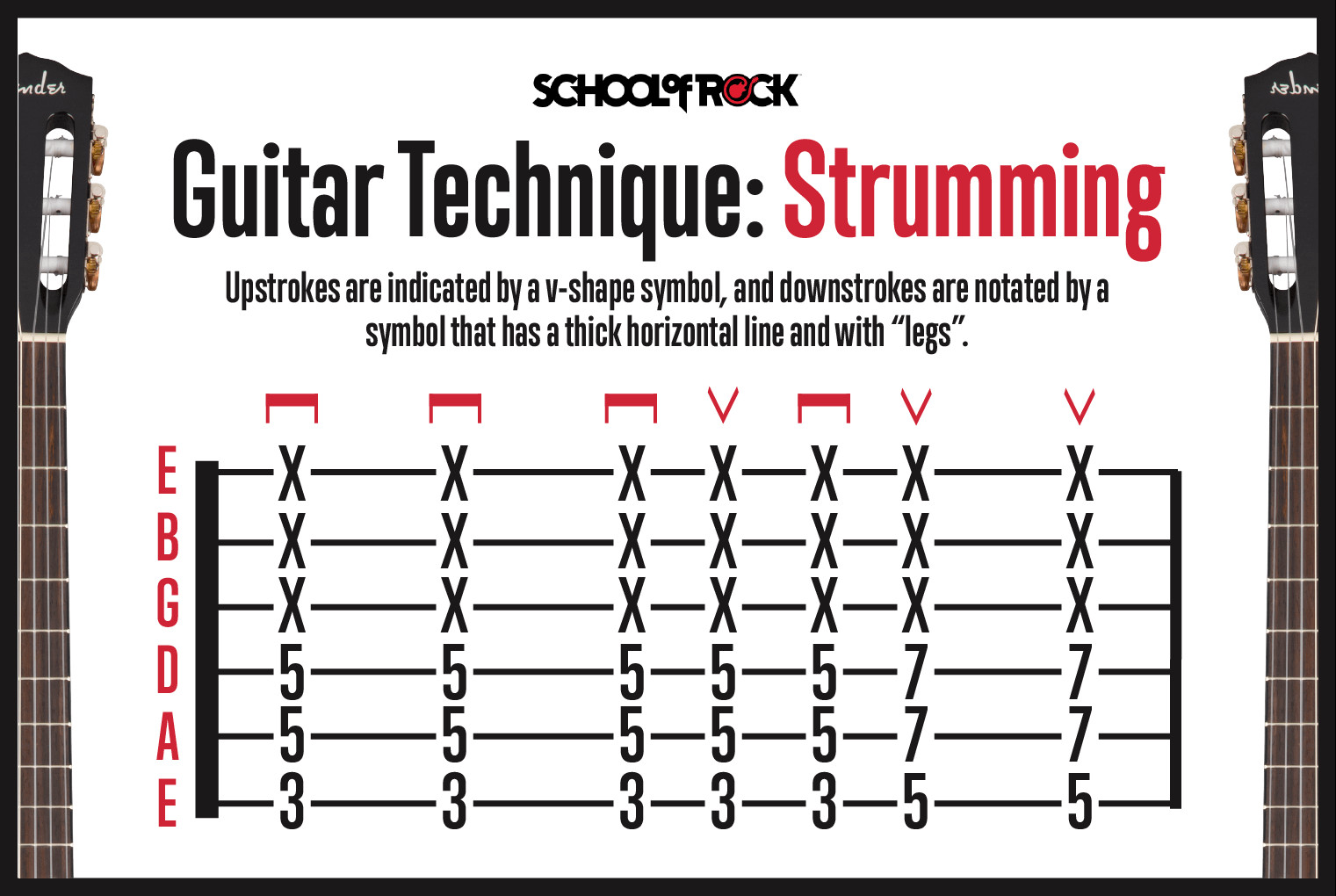 Strumming Notation in Guitar Tabs
Strumming Notation in Guitar Tabs
Understanding Strumming Patterns
Strumming patterns depend on the song’s rhythm. You can use constant downstrokes, upstrokes, or combinations. Eighth-note rhythms are often counted as “1 and 2 and 3 and 4 and…”. Many songs use alternating downstrokes (on the beat – 1, 2, 3, 4) and upstrokes (on the “ands” – and).
Strumming Single Notes
The same upstroke and downstroke notation applies to single notes in tabs. Downstrokes are indicated by the horizontal bar with “legs,” and upstrokes by the “V” symbol above the note.
Ready to Explore More Guitar Techniques?
Now that you’ve learned how to read guitar tabs and understand common guitar techniques, you’re equipped to start playing! From fundamental strumming to advanced tapping, guitarplayers.net is dedicated to helping musicians of all levels reach their full potential. Our resources and guides are designed to help you quickly learn your favorite songs and develop your guitar skills.
Eager to find guitar tabs? Whether you’re looking for easy beginner songs or challenging pieces, explore online tab resources like Ultimate-Guitar, Songsterr, and Guitar Tabs. These platforms offer vast libraries of guitar tabs for virtually any song you can imagine.
Thinking about a new guitar? Check out our comprehensive Guitar Buying Guide!
